It has been eight years since my co-founders and I sat in a pizza shop. We were nearing college graduation, and Interact was just a fledgling idea that had yet to make any money. I looked at them and said, “Sooo, you guys want to work on this full time when we graduate?” And without blinking an eye, they were like, “Yeah, we’re in.”
Since then, we’ve been fortunate to grow Interact to millions in revenue, build an amazing team that has carried the company far beyond what we’d imagined, and make a real impact in the world of marketing. Here are the 8 biggest lessons we’ve learned through the years.
- Ask the scary questions
- Persistence wins over everything else
- (In the beginning) you can only serve one type of customer
- Mentors matter
- Working with the right people is the only way to scale
- Be the best in the world at one thing
- People over profit = sustainable (and happy) growth
- The company follows where your mind leads
Each of these lessons comes with a story, here are the stories behind the learnings.
1. Ask the questions you are afraid to know the answer to

I remember the conversation like it just happened. I was sitting in a loud coffee shop where I liked to work, and the person on the other end of the line was giving me feedback on our product.
Interact had been operating for three years, and I’d never asked anyone to critique anything we’d built before that point.
The notes this person offered were brutal; almost none of the elements of our quiz builder connected with him, and he was supremely confused. Even the words we’d used in our copy weren’t right.
This went on for an hour. By the end of it, I felt like I’d just gone nine rounds with Mike Tyson. I slumped in my barstool and then went on a walk, taking the rest of the day off to absorb the verbal barrage of our creation.
A few weeks later, we implemented this person’s feedback and immediately saw a 15% boost in paid signups. That was when I understood the power of asking the questions I was afraid to know the answer to.
It is super freaking hard to listen when people critique my work; it makes me feel like I’ve failed. If, like me, you grew up in an environment where perfectionism was expected and harsh feedback followed by shame was commonplace, you know it can be way easier to just plod on without asking questions.
For myself and Interact, we’ve learned over the years that some people will be very harsh with their words, even using shame and manipulation to get what they want. But there are kind people, too, and listening to them can help us get out of ruts, move forward, and grow.
It is now standard practice for us to start every project by talking with our customers and potential customers, spending hours on the phone diving deep into their needs, understanding how they could use our products, and getting a broader picture of their businesses and lives.
Listening has paid enormous dividends. So many of our great ideas have come from other people. And sure, people may say that there’s nothing new under the sun, but for us, it’s not so much about creating something out of thin air as it is mixing hard work with real talk so that the right ideas can surface.
One practical takeaway for our team is to implement feedback sessions into our long-term workflow. When we start a project, we plan to spend a day or two every quarter talking with customers and users to hear what they think.
Even on our content initiatives like our podcast or blog, we ask for this type of insight. It helps us stay on track and ensure that what we’re building is actually what the customer wants and not just what is in our heads.
2. Persistence wins over everything else
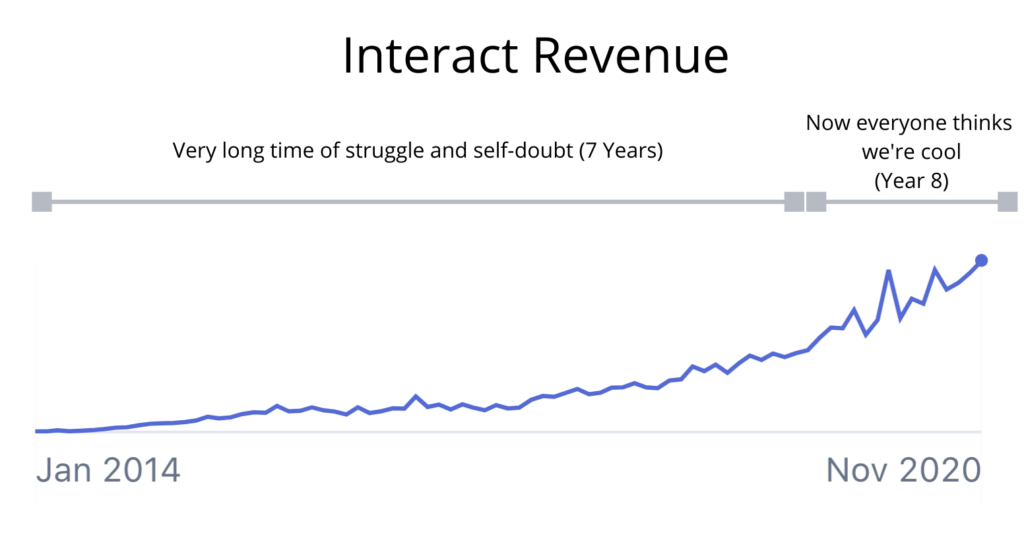
Interact didn’t start growing exponentially until our seventh year in business. Before that, it was very slow but steady linear growth.
When we first started Interact, I read a lot of publications that talked about how fast a new startup should be growing. They said 10% each week. We did that for the first six months, and then things started to taper off . . . for six and a half years.
I didn’t know what to do with that. I felt like we were failing, like we weren’t living up to expectations. Finding myself in a business situation where I thought I wasn’t measuring up was an unbearable feeling because I have struggled with telling myself I’m not good enough all my life.
The first attempt to get things going was with content marketing. Our initial success came through blog posts, so I wrote hundreds of more blog posts—no dice.
Then we tried hiring sales teams to sell the product directly. We spent two years and $250,000 on that, hiring and letting go of two different teams of people—no results.
Then we hired people to take over general operations at Interact, and I started an affiliate marketing program. That sort of worked, but I was running it inefficiently, and it drove us deep into debt.
That all sounds like a nice little video montage, but that series of events took place over many years, and during that time, Interact was struggling to stay afloat. There were 18 months in a row where we could hardly make payroll, and I would often have to transfer money from my personal accounts to cover business expenses at the end of each month.
It was thoroughly exhausting and defeating every time we’d get really excited about a new way to grow, only to watch it fall flat again. But with each failure, we learned something, and after many attempts, good luck, and some good people, we did finally break through and hit the stride that all the startup publications love to write about.
It’s funny because now is when the publications would definitely write about Interact as if it had just come on the scene—this I know because my friends who run startups that were founded 10 years ago are getting written about in the news as if they just started.
In reality, our story, while difficult and hard, is super typical. The more founders I get to know, the more I hear echoes of what happened at Interact, where so many strategies are tried and fail. There are countless moments of desperation and near collapse, and really the only throughline is that the companies that win out end up persisting.
Caveat: Persistence in a box still fails

Interact got its first customers from a blog post. I followed the mantra of never giving up, and it got us to that first goal. Then I figured I should keep going, and after that first blog post, I wrote a new blog post every day for the next year. It was totally logical that if one post got us customers, then we should make more posts.
I would hole up in my apartment and type out a thousand words every single day because that’s the advice I had read from people who write books.
Long story short: we are now deleting or redirecting 215 blog posts—the vast majority of what I wrote during that year. The reason is because I wasn’t checking to see if they were delivering results. I didn’t want to know; I just needed to feel like I was accomplishing something every day.
This circles back to point #1: asking questions. For example, “Are my blog posts actually driving new customers?” Back then, I would have rather just felt productive than know if what I was doing was helping.
That is something I picked up in adolescence, in a house where working hard was prioritized over paying attention to results. I was taught to just keep working away at things, even if my work was inefficient. For Interact, that worked for the initial phase, but then I needed to get answers to questions.
Looking back, there’s no real way I could have known this; looking forward, we now know to pay attention, to stop and evaluate what we are doing.
It’s a fine line because, especially in marketing, it takes years for new initiatives to start working, so it’s tempting to just “set it and forget it,” but then we could run into situations similar to my 215 useless blog posts.
At this point, what we generally do is give things three months at a time to play out. Three months to focus, push out work, and not second-guess ourselves. Then we check in on progress, make adjustments, and decide whether to continue.
Now, I’m not saying to just keep going at all costs. My co-founder and I, and now with our executive team, are brutally honest with ourselves about progress and growth. We also place a huge emphasis on mental health and, as we’ve grown, have realized that pushing too hard and trying to force something to happen never works. Burnout is inevitable if we don’t proactively think about how to keep work within healthy boundaries.
When you keep priorities, boundaries, and mental health in mind, going for the long-haul becomes more attainable. One of the most important lessons we’ve learned at Interact is that if something is going to work, it will take at least a decade of your life.
3. You can only serve one customer

When Interact first started gaining traction, we would get inquiries from many of the world’s largest companies.
It was wild to be sitting in the apartment where my co-founder and I both lived, getting messages from organizations like The American Red Cross or Eventbrite. The attention enthralled us, and we didn’t want to lose any single request we got.
After all, there was no guarantee that we’d keep getting new customers, so it felt like we had to maximize every opportunity.
What we did, as a result, was bend over backward for each new company that wanted to work with us.
In particular, one thing we’d do was host custom fonts on our servers for customers who wanted that ability.
The way our systems were set up, we had to replicate our entire product for each custom font request. Before long, maintaining all the fonts became a part-time job. It began to slow us down dramatically, the time spent on upkeep started to outpace time spent building new features. And before long, it became unsustainable.
To worsen matters, all customers wanting custom fonts canceled within a year or two, leaving us in a lurch.
We learned the hard way that we couldn’t serve everyone. It was only after experiencing the painful defeat of pandering to the individual wants of each customer and then having those same customers disappear overnight, that we realized we had to get serious about focusing on meeting the needs of one type of customer.
That led to a long journey, which has now culminated in focusing on the small business market—people who are creating and selling services and digital and physical products.
We chose this market because service providers and creators often have the same general use-case for their quizzes.
It’s pertinent for us to focus on one market because each way of using a quiz requires a depth of features and expertise that we’ve now realized take years to build—especially with limited resources like ours.
It’s scary. Choosing one market means we are not choosing lots of other markets, and while people from other industries can certainly still use Interact, it’s designed and built for service providers and creators. People from other industries will find Interact to be less useful than alternative products and leave in the long run.
Customers fitting our market are happier, staying longer, and upkeep costs have decreased.
We fully believe we can become a large company in this one market, but unless we expand, we will never become the next giant software business that graces the cover of Forbes.
For us, that’s okay. We can always expand later. We know that if we try to do everything right now, it will ruin us.
We saw that in our business when we tried to serve everyone, and we’ve seen it in some of our competition when they flew high for a few years only to sputter and die because of overwhelming demands on their team.
4. Mentors matter
In the throes of despair, when Interact had not gotten off the ground and I was writing for three to four hours a day while also finishing school and juggling client work, there was one story that really kept me going.
It’s from Geraldine DeRuiter, the blogger behind The Everywherist. It took 18 months of full-time work to gain traction on her blog. She’d written 500+ blog posts before the traffic started to pick up.
When I was writing the first 100 blog posts at Interact (post 108 got us our first customers), I’d read Geraldine’s story and feel some okayness around how hard it was for us because her story normalized it.

On the other hand, I have also read a lot of TechCrunch and similar publications that talk about the exponential, insane growth of Silicon Valley startups. I’d feel so far behind as I read about startups growing 10% every week, when we struggled to grow that much in a month.
There’s a line from a song that I like: “The mind is a powerful place. And what you feed it can affect you in a powerful way.” That is super true for me and Interact.
When we were operating out of a place where we were trying to keep up with the startups I was reading about, I made some bad decisions optimized for short-term growth, as opposed to listening to people like Geraldine who are more honest with how long it takes to build something of value.
What I’ve learned is that if something works and is a long-term strategy, it won’t start to yield results until the latter part of year one. It won’t start to really unfold until later on.
Eight years after reading Geraldine’s story, we have one of those crazy graphs, too. This is our search traffic since 2014, which basically looks like zero until recently. This is not to say that we had no traffic—search has been our number one driver of success since the beginning.

It’s almost eerie how similar these graphs are, especially when it comes to search engine rankings. At a glance, it tells me that if you don’t give up for a very long time, you will find success. But still, success is not guaranteed—you have to give your best effort.
Another thing we’ve learned is that certain pacing has to happen. One of my mentors says, “persistence + effort = results.” This is so true. But persistence only comes when there is a cadence of work and rest. As far as I know, no human being can work at full tilt for eight years without being completely miserable.
My point is that it matters who we listen to. When I was ingesting articles about Silicon Valley startups and overnight successes, I tried to hammer away and grow fast, which left us burnt out, exhausted, and stuck.
When I focused on the articles about long-term growth and patience, it ended up building the company that Interact is today—self-funded, profitable, and enjoyable.
5. Working with the right people is the only way to scale

Matt and I were running on the beach last year, reminiscing about the seven years of Interact’s existence. As we counted the waves of people who had worked at Interact, we realized that seven cohorts of employees had come and gone over the seven years of our existence.
Now, I want to be very clear that no one who has worked at Interact is anything less than skillful and gifted. Everyone has had great ability and brought value to our company in unique ways.
But the challenges we face as a bootstrapped startup in the marketing world are unique. It took a long time to find the people who could take on those challenges, own them, and help us navigate through the barrage of difficulties on our unique path.
What I’ve realized is that the right people take work off of my plate. They give me space to think and develop Interact’s next phase. Whereas people who are not the right fit end up taking more of my time—not because there is anything wrong with them, but because it’s just not the right fit.
As we scale, each new team member needs to own their area of the business and operate independently. Otherwise, the bigger we get, the less fun it will become to be CEO of Interact, and, over time, I would start to get tired of being responsible for everything.
The best-case scenario is working with people who enjoy taking responsibility for parts of the business. Kind of like the fish from Finding Nemo, all “swimming down” together.
People who take ownership of their roles end up giving all of us more strength, and we pull together to build Interact. As opposed to the old version that failed over and over again, where everything came back to me, and it was all on me to move things forward.
6. Be the best in the world at one thing
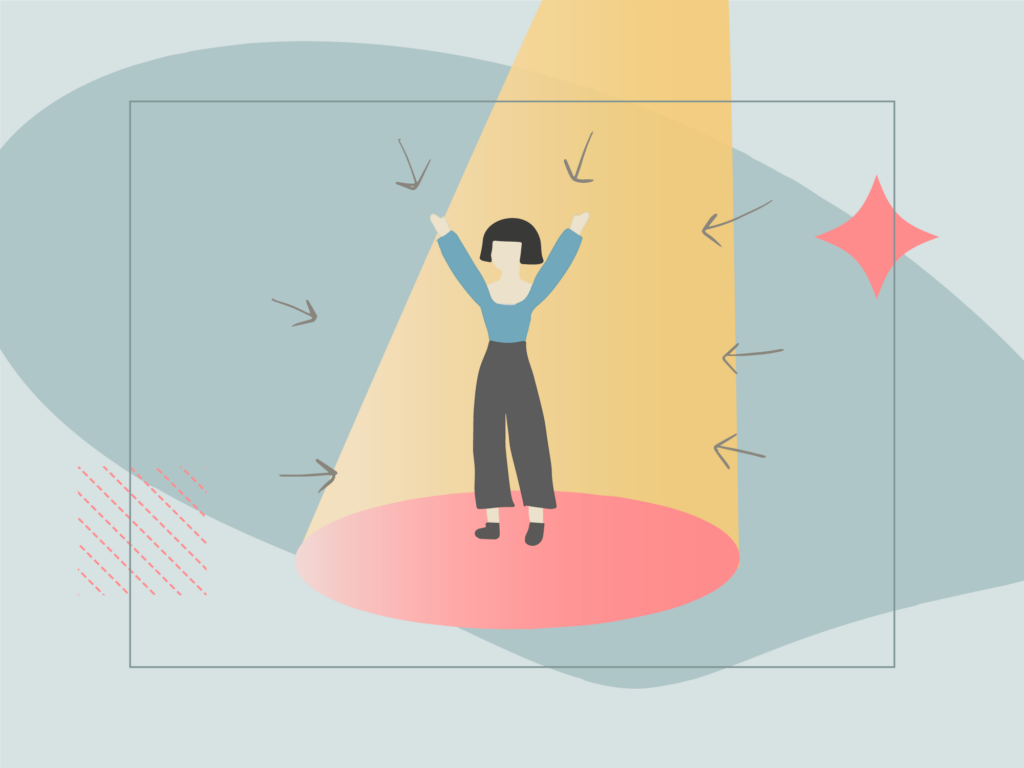
I attended a lecture by the VP of Business Development at Pandora in 2013, and she said something that changed the way Interact has operated for the last decade. She said that all you have to do is “be the best in the world at one thing.” For Pandora, it’s their music suggestion algorithm that sets them apart. For Interact, it’s using quizzes to create human connections.
To show just how insanely dedicated we are to doing business this way, here are two screenshots of Interact: one is from August 13, 2013 when we first launched our website, and the other is from December 7, 2020.
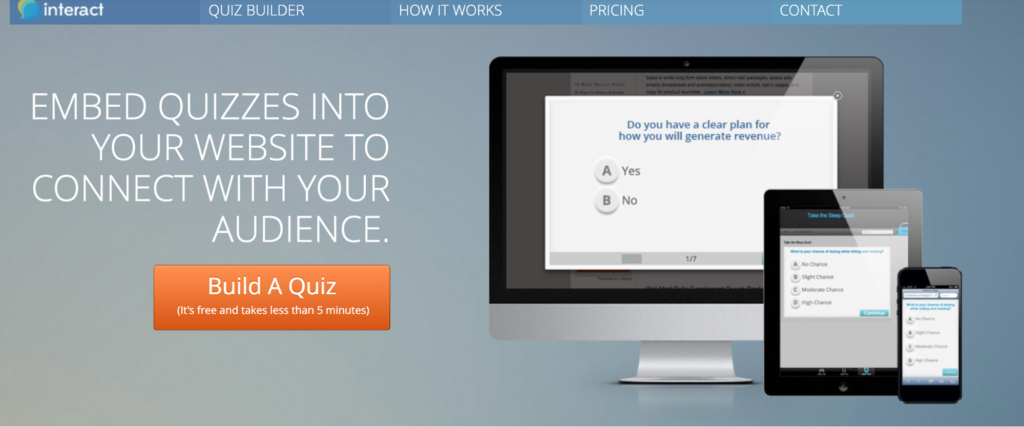
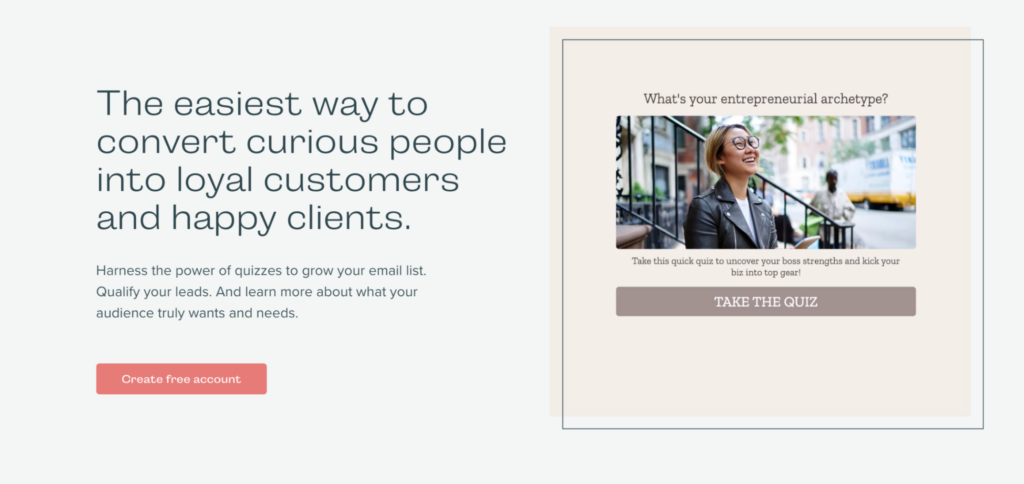
Not much has changed, and that’s on purpose. We started Interact because we saw how powerful quizzes can be for building an email list, which is the first step in business connection. From day one, we stuck to that concept—even through the years when the concept was too “out there” for anyone to really adopt.
But we stuck to our main goal of being the best possible quiz solution for building an email list, and even during those years of wandering, we continued to work on the quiz builder.
When I look at survey data now, I see two points of feedback that show up over and over again. The first is that Interact is easier to use than any other tool, and the second is that it helps build email lists.
We learned that it is really hard to build an easy-to-use tool for anything, even something as simple as a quiz builder, which in its essence is just a form you fill out to make another form (quiz).
It’s amazing how many steps are involved in building a quiz, and thanks to our incredible product team, we’ve taken that process and dissected it down before building it back up.
We fully believe that staying hyper-focused on being the easiest quiz builder that helps people build their email lists has allowed us to stay afloat and thrive despite competition with more money, resources, and comprehensive products.
We’ve now seen several waves of quiz builders come and go. Each with millions or tens of millions of dollars of funding behind them. The mistake they all make is trying to do too much. They want every customer, just like we did, and so they go broad.
Sure, for us, focusing on one solution limits our overall potential (hypothetically), so if we had investors, they probably wouldn’t love that decision. But I think we would have died a long time ago if it wasn’t for a ruthless focus on being the best in the world at one thing.
7. People over profit = Sustainable success
Two years into running Interact, I opened up our revenue analytics. Most of our revenue was coming in from our middle plan, which at the time was a few hundred dollars a month.
With my mind set on growing as quickly as possible and taking over the world, I decided to nix our free offering and lowest-cost plan, then I doubled the cost of our middle plan, up to $450 a month. (If you’re an Interact customer today, I can feel your rage at the thought of our current product being $450 a month.)
I forget who I was reading, but they said that to double your revenue, you should double your prices. And they were right. We doubled the price, and we doubled our take-home income.
It was amazing at first. It felt like some sort of hack that everyone else just didn’t know about. We had big companies paying us $450 or $950 a month to use our product, and we started making a lot of money every month. We had a board on the wall and would note every sale that came in, and they just kept rolling in.
But then the support for these customers started to kick in. I remember one customer in particular that I had twice-a-week calls with: I would jump on and advise this team on quiz strategy, business strategy, and marketing strategy. These calls would often go way over time, lasting an hour or more.
We also started to get fewer leads coming in the door. At first, it was ten solid customers each month, then eight, then six, then four—it was like the well was starting to dry up.
Then, within a matter of two months, 30% of our biggest customers called to cancel. Many of them asked for their money back because they couldn’t actually implement their quizzes and felt like they’d been paying for nothing, even though I’d been on the phone with them for hours and hours.
I then had to let go of two of our employees, bringing our team back down to three people. This was three years into running Interact. It was the worst.
Around this time, I read an article by Hiten Shah, and he said:
“We used to have a free plan at Crazy Egg and decided to stop making it available for new customers. It was a short-term great decision for increasing revenue but I believe it was not the best decision for the long-term.”
I knew right away that what he was saying applied to us. It was obvious that we were losing out on long-term growth because I’d tried to maximize in the moment.
We re-introduced the free plan, dropped our prices to where they are today, and cut down on expenses. It had only been nine months since I raised the prices way up to maximize revenue, but it took another year for us to recover, resulting in 18 months where our income was pretty much flat.
It was deflating to see our monthly revenue stay the same during years three through five of Interact.
Being in this business for a decade now, we’ve seen several waves of competitors come and go. Each one makes exactly the same mistake, and we’re not immune. The downfall always goes like this: company starts, company gets customers, company begins to grow quickly, company scrambles to maximize profits, company angers their customers as a result of maximizing revenue, company fails.
That’s very simplified, but it’s what I believe happens. At Interact, we now leave money on the table all the time. Not on purpose, of course; we want to make money so we can take good care of our team members, build better products, and enjoy our lives, but we’re constantly making updates that lead to instant bumps in revenue that we’ve put off for years in favor of improving our product.
For example, we are just now working on the upgrade process. We put it off for five years because it doesn’t improve customer experience, and the main incentive is to increase our revenue. The upgrade process has constantly been bumped from the priorities list. Now we have more capacity to get projects done, so we’re doing it, but it came on the heels of many projects that were meant to delight customers.
“Past me” would have demanded that we do those upgrade pages before anything else because they would make us more money, but “current me” sees that it’s more important to put customers ahead of short-term profits. I want to create a sustainable business that can last another ten years or longer.
8. The company follows your mind
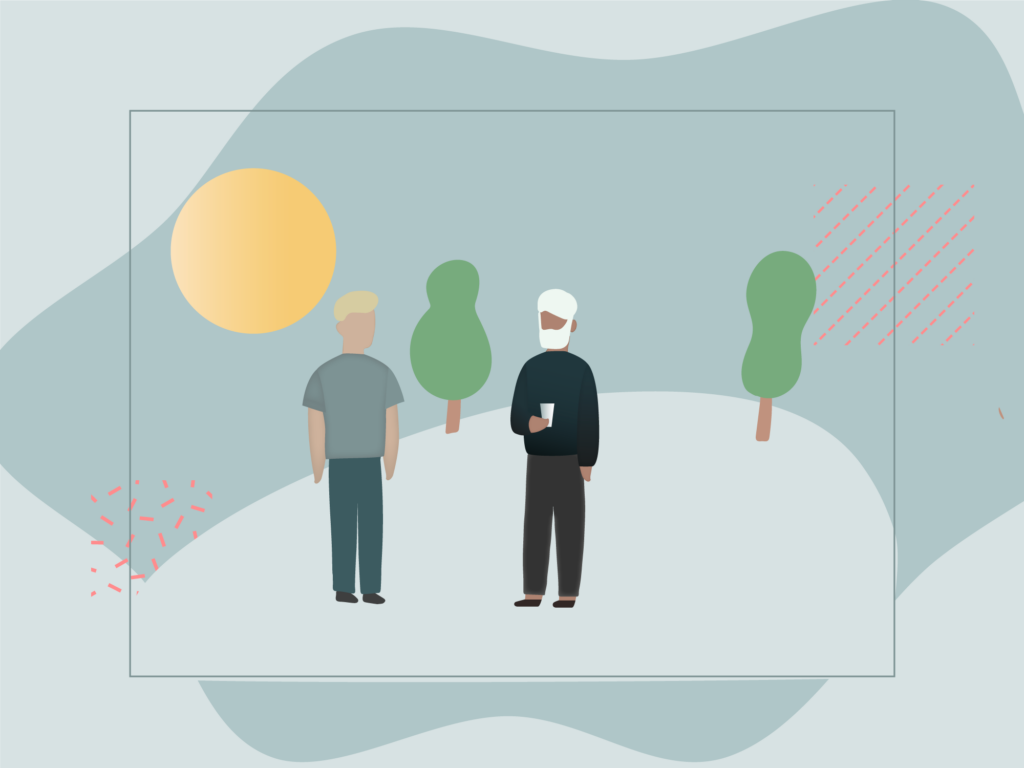
Years ago, I walked down Market Street in San Francisco in my tailored, purple-plaid shirt, full of false confidence. Arriving at my destination, a sandwich shop, I sat down across from a business coach I’d been introduced to for a consultation.
I assured him that everything was pretty much A-OK at Interact, with the exception of things sometimes getting a bit stressful. He listened without judgment, asking questions about specifics of my day-to-day and company, never pressing me on anything.
I was unaware of how bad things were. Interact was just getting started. We were upside-down and had to work really hard every month to pay everyone, and my mental state was frazzled, propped up by multiple coffees and hours of basketball every day.
We were two years into business, and my bravado was blinding me to the realities of our situation.
I continued to meet with that coach, and for months on end, our conversations looked nearly identical, with me talking about what deals had gone through that week and complaining about issues we were having. Same old, same old.
Then, after about six months, my coach offered up a reflection. He said, “I can tell how you are doing when you walk into our meeting, based on how sales have gone in the past week.” He was right, I didn’t deny it, but he said it in such a non-shaming way that I was open to talking about it. He didn’t imply that it was a bad thing, or even that it was something that needed to be fixed.
Good thing, because I didn’t “fix it” for another several years. Every week, my coach offered his listening ear and helpful reflections, giving me prompts for things to try that could help with my anxiety or other struggles. Never pushing, merely suggesting.
It was truly the first time in my life someone had just let me be. Not trying to change me, make me into something else, mold me to what they thought I should be. He just let me live.
After some time, I realized that I didn’t want my happiness to be linked to our weekly sales numbers. I didn’t want to get upset at people for getting in the way of Interact’s growth. I wanted to be connected to other human beings and my faith, but I also really enjoyed building a company.
My coach is one of my closest friends. We have met every week, often multiple times a week, for the last six years, and it has changed my life and the trajectory of Interact in innumerable ways.
Both my co-founder and I do coaching now, and for Interact’s success, we know it’s crucial to work on our minds intentionally, so we can choose to stick to the things that are important to us when everything gets crazy (which is often).
In Conclusion
If you’ve read this far—thank you. I sincerely appreciate you taking the time to read Interact’s story. My reflection on writing this post over the last nine months is that there are no right answers to how a business grows.
The lessons I learn at Interact are ever-shifting sands. There are, of course, some constants (like what’s outlined above), but as I meet more entrepreneurs and am exposed to different ways of approaching the world, I realize that I have so much to learn from others who do things differently than I do.
I am very curious to hear what comes up for you after reading this post—stories, experiences, opposing viewpoints. Let’s chat about it.